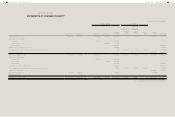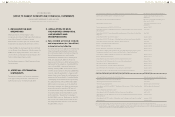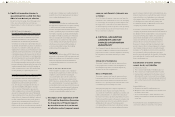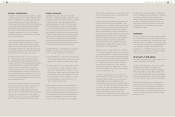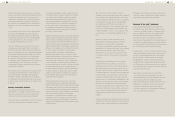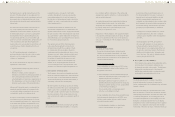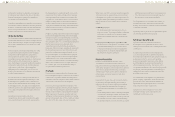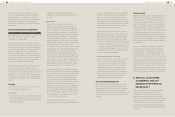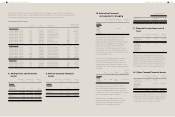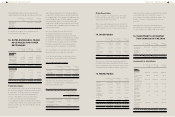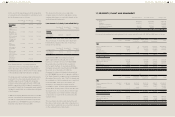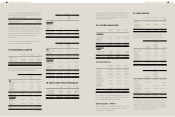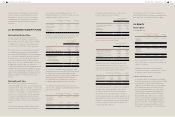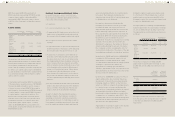HTC 2013 Annual Report Download - page 100
Download and view the complete annual report
Please find page 100 of the 2013 HTC annual report below. You can navigate through the pages in the report by either clicking on the pages listed below, or by using the keyword search tool below to find specific information within the annual report.
FINANCIAL INFORMATION FINANCIAL INFORMATION
196 197
instruments is positive, the derivative is recognized
as a financial asset; when the fair value of derivative
financial instruments is negative, the derivative is
recognized as a financial liability.
Derivatives embedded in non-derivative host contracts
are treated as separate derivatives when they meet the
definition of a derivative, their risks and characteristics
are not closely related to those of the host contracts
and the contracts are not measured at FVTPL.
Hedge Accounting
The Company designates certain hedging instruments,
which include derivatives in respect of foreign currency
risk as cash flow hedges. Hedges of foreign exchange
risk on firm commitments are accounted for as cash
flow hedges.
At the inception of the hedge relationship, the entity
documents the relationship between the hedging
instrument and the hedged item, along with its
risk management objectives and its strategy for
undertaking various hedge transactions. Furthermore,
at the inception of the hedge and on an ongoing
basis, the Company documents whether the hedging
instrument is highly effective in offsetting changes
in fair values or cash flows of the hedged item
attributable to the hedged risk. Note 32 sets out
details of the fair values of the derivative instruments
used for hedging purposes.
The effective portion of changes in the fair value of
derivatives that are designated and qualify as cash
flow hedges is recognized in other comprehensive
income and accumulated under the heading of cash
flow hedging reserve. The gain or loss relating to the
ineffective portion is recognized immediately in profit
or loss, and is included in the 'other gains and losses'
line item.
Amounts previously recognized in other
comprehensive income and accumulated in equity
are reclassified to profit or loss in the periods when
When some or all of the economic benefits required to
settle a provision are expected to be recovered from
a third party, a receivable is recognized as an asset if it
is virtually certain that reimbursement will be received
and the amount of the receivable can be measured
reliably.
a. Warranty provisions
The Company provides warranty service for one
year to two years. The warranty liability is estimated
on the basis of evaluation of the products under
warranty, past warranty experience, and pertinent
factors.
b. Provisions for contingent loss on purchase orders
The provision for contingent loss on purchase orders
is estimated after taking into account the effects
of changes in the product market, evaluating the
foregoing effects on inventory management and
adjusting the Company's purchases.
Revenue Recognition
Revenue is measured at the fair value of the
consideration received or receivable. Revenue is
reduced for estimated customer returns, rebates and
other similar allowances. Sales returns are recognized
at the time of sale provided the seller can reliably
estimate future returns and recognizes a liability for
returns based on previous experience and other
relevant factors.
Revenue from the sale of goods is recognized when
the goods are delivered and titles have passed, at
which time all the following conditions are satisfied:
‧ The Company has transferred to the buyer the
significant risks and rewards of ownership of the
goods;
‧ The Company retains neither continuing managerial
involvement to the degree usually associated with
ownership nor effective control over the goods sold;
‧ The amount of revenue can be measured reliably;
‧ It is probable that the economic benefits associated
the hedged item is recognized in profit or loss, in the
same line as the recognized hedged item. However,
when the hedged forecast transaction results in the
recognition of a non-financial asset or a non-financial
liability, the gains and losses previously recognized
in other comprehensive income and accumulated in
equity are transferred from equity and included in the
initial measurement of the cost of the non-financial
asset or non-financial liability.
Hedge accounting is discontinued when the Company
revokes the hedging relationship, when the hedging
instrument expires or is sold, terminated, or exercised,
or when it no longer qualifies for hedge accounting.
The cumulative gain or loss on the hedging instrument
that has been previously recognized in other
comprehensive income from the period when the
hedge was effective remains separately in equity until
the forecast transaction occurs. When the forecast
transaction is ultimately recognized in profit or loss,
the associated gains or losses that were recognized
in other comprehensive income are reclassified from
equity to profit or loss or are included in the initial
cost of the non-financial asset or non-financial liability.
When a forecast transaction is no longer expected
to occur, the gain or loss accumulated in equity is
recognized immediately in profit or loss.
Provisions
Provisions are recognized when the Company has a
present obligation (legal or constructive) as a result of
a past event, it is probable that the Company will be
required to settle the obligation, and a reliable estimate
can be made of the amount of the obligation.
Provisions are measured at the best estimate of the
consideration required to settle the present obligation
at the end of the reporting period, taking into account
the risks and uncertainties surrounding the obligation.
When a provision is measured using the cash flows
estimated to settle the present obligation, its carrying
amount is the present value of those cash flows (when
the effect of the time value of money is material).
with the transaction will flow to the Company; and
‧ The costs incurred or to be incurred in respect of
the transaction can be measured reliably.
The Company does not recognize sales revenue on
materials delivered to subcontractors because this
delivery does not involve a transfer of risks and rewards
of materials ownership.
Specifically, sales of goods are recognized when goods
are delivered and title has been passed.
Retirement Benefit Costs
Payments to defined contribution retirement
benefit plans are recognized as an expense when
employees have rendered service entitling them to the
contributions.
For defined benefit retirement benefit plans, the
cost of providing benefits is determined using the
Projected Unit Credit Method, with actuarial valuations
being carried out at the end of each reporting
period. Actuarial gains and losses on the defined
benefit obligation are recognized immediately in
other comprehensive income. Past service cost is
recognized immediately to the extent that the benefits
are already vested, and otherwise is amortized on a
straight-line basis over the average period until the
benefits become vested.
The retirement benefit obligation recognized in the
parent company only balance sheet represents the
present value of the defined benefit obligation as
adjusted for unrecognized past service cost, and as
reduced by the fair value of plan assets.
Curtailment or settlement gains or losses on the
defined benefit plan are recognized when the
curtailment or settlement occurs.



